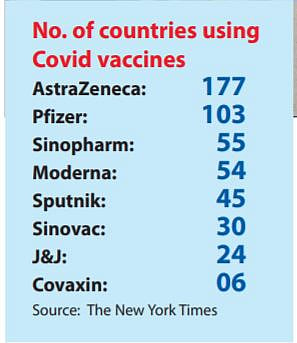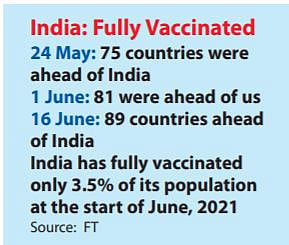How India faltered and frittered away its 'vaccine' expertise built since 1850
The oldest vaccine manufacturing facilities came up between 1850 and 1907. They are still active. India has 26 institutions engaged in R and D. It vaccinated 172 mn children in just five days in 2011

Vaccine hesitancy in the country is increasing, says Professor Gagandeep Kang and there is no reason to doubt her. But why is the question. Is it because of the huge amount of confusion created by a surfeit of official directives on Covid vaccines? Or could it be due to the hurried approval given to Covaxin without observing due processes, as a result of which it is not yet approved by the WHO and countries like the US.
If I were a young woman wanting to be a global citizen, I too would be alarmed at the thought that I have taken a vaccine which is not even internationally recognised. Why would anyone want to take something that will not help her cross borders? How indeed is it designed to inspire confidence?
Where is the data related to the Universal Immunisation Programme for 2019 onwards? Just because the PM says there is 90 per cent coverage, do we have to take it as God’s own truth? WHO, UNICEF, GAVI, HMIS data seem to contradict the Prime Minister’s claim. The PM also claimed there was only 60 per cent coverage before 2014. Does that mean that the Measles-Rubella vaccine has covered all children born after 2015, or for that matter the Polio vaccine?
Data in fact do not paint a rosy picture of any immunisation programme in India. ‘The NIP coverage ‘is suboptimal and only 3/5th children receive all due vaccines and only 3/4th receive 3 doses of DPT vaccine’, says one international oversight. Data recording and reporting is also sub-optimal and ‘lack of supervision and monitoring is often cited; communication for increasing immunization coverage is limited’, the report states.

In 2016, 38 per cent of infants in India failed to receive all the basic vaccines within the first year of their birth. There are 27 million new-borns to be vaccinated annually for the basics. Add about 30 million pregnant women to this.
But India ranked between the 51st and 75th among 89 countries on effective vaccine management according to a global analysis by WHO-UNICEF in 2018. If the ranking for management of vaccines was low (62), ranking for the maintenance of key logistical components was also low (64).
According to data from the Health Management Information System, immunisation programmes suffered a significant disruption during the lockdown, with levels falling substantially from January to June 2020. What is the data for the same period in 2021? We do not yet know.
India in 2017 had pledged to vaccinate 410 million children and adolescents up to 15 years of age under the world’s largest MR (Measles-Rubella) campaign by 2020. As of November 2018, 135 million children were vaccinated. Between May 2018 and April 2019, India reported 47,056 measles cases and 1,263 Rubella cases. Figures from 2019 to 2021 are awaited.
Are all children up to 15 years in poll-bound Uttar Pradesh vaccinated and is the coverage 90 per cent? And what about Bihar?

Let us look at Corona vaccine. The country’s immediate need is two billion doses. The country would get 120 million vaccines in June, the Government had claimed. Professor R Ramakumar of the Tata Institute of Social Sciences questioned the claim and said the government had fudged production capacity.
Production capacity had to be around 150 million doses a month for 120 million vaccines to be administered in June. But SII and Bharat Biotech together produced, at best, about 80 million vaccines in May. Prof Ramakumar points out that only about 51 million doses of vaccines were administered in May (5.98 crore) as reported in the CoWIN app.
Experts say it takes two months of processing for the Corona virus to be ready to become a vaccine. Obviously 120 million doses, for being administered in June, should have been processed from February-March this year.
With Covaxin still awaiting WHO approval, Sputnik being an unknown quantity, Astra Zeneca in trouble in Europe just as the J&J vaccine and confusing signals from the government about gaps between doses, the confusion among people is complete. Zydus Cadila isn’t there yet. That leaves us with Pfizer. Where does it leave the 100 million underprivileged children?

Amidst these doubts comes the announcement from the government in Tamil Nadu that the 114-year-old Pasteur Institute of India can produce 10 crore vaccines in a month, that is 100 million doses. It only needed the raw materials, said Tamil Nadu Health Minister Ma Subramaniam. Where has the PII been for so long?
Indeed, vaccine making has a long history in India and began in Bombay and Madras after 1850. The Compulsory Vaccination Act was passed in 1892. On record, the law was in force in approximately 80 per cent of the districts of British India in 1938 and apparently exists even now.
In 1893, Waldemar Haffkine conducted Cholera vaccine trial in the city of Agra. When a plague epidemic started in 1896, the British India government asked Haffkine to work on a plague vaccine and provided him with two rooms in the Grant Medical College to set up his lab. Haffkine developed plague vaccine in 1897, the first vaccine developed in India.
The GMC is a tourist site today. The story of the search for the carrier and the vaccine is recorded in the book Room 000, written by two doctors, Kalpish and Ratna. After 1899 a full-fledged bacteriological lab was established, now known as the Haffkine Institute.
The smallpox vaccine began to be made in Shillong and a few other places since 1890. In 1905, the Central Research Institute was set up in Kasauli, followed by the Pasteur Institute in Coonoor two years later. Over the years, PII produced anti-rabbis’ vaccines, polio vaccines and has been a major research institute for influenza vaccines; corona is a SARS flu virus. The institutional structures of these four ‘oldest vaccine making institutions’ in India are based on the innovation model where R&D and Production co-exist under the same roof, point out experts. Why have they been kept out of Covid vaccines is the question.
When India earned its freedom, Tuberculosis was a major issue and BCG vaccines began to be made at King Institute, Madras in 1948. When India was declared Smallpox free in 1977, the country went in for a national immunisation programme. Countrywide immunisation got further fillip when it was added to Prime Minister Indira Gandhi’s 20-point programme. Immunization was again given the status of one of the five National Technology Missions in 1986 and began to be called the Universal Immunisation Programme(UIP). Coverage target became hundred per cent after 1990. And today we have 27 vaccines under UIP.
From 2008 to 2010, the government had suspended the licenses of the three public sector manufacturing units, Central Research Institute (CRI), Kasauli, Pasteur Institute of India, Coonoor and BCG Vaccine Laboratory, Chennai due to protocol issues.
But not only are they fully operational for the last one decade, there are also around 26 vaccine R&D institutions in India that are actively engaged in research and development. There are 2 institutes under DBT (came up in late 1980s), 11 under ICMR (came up between 1950s - 1990s), 6 under CSIR, and others include university departments and other autonomous institutions like AIIMS New Delhi, IISC Bangalore etc.
Except for Rotavirus, India thus has capability for making most vaccines in the world. So, I am left wondering why the government took until May 2021 to permit other organisations to make the covid vaccines; why did it restrict it to just SII and Bharat Biotech when all over the world vaccine trials had begun in the winter of 2019?
Follow us on: Facebook, Twitter, Google News, Instagram
Join our official telegram channel (@nationalherald) and stay updated with the latest headlines
